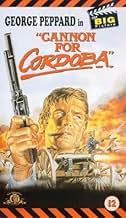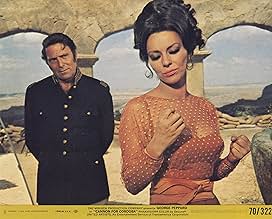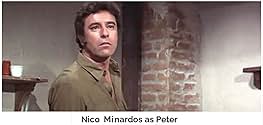IMDb RATING
5.7/10
840
YOUR RATING
In 1916, when a Mexican rebel steals cannons from the American army, General Pershing sends out a group of misfits to retrieve the stolen weapons.In 1916, when a Mexican rebel steals cannons from the American army, General Pershing sends out a group of misfits to retrieve the stolen weapons.In 1916, when a Mexican rebel steals cannons from the American army, General Pershing sends out a group of misfits to retrieve the stolen weapons.
Charles Stalnaker
- Capt. Riggs
- (as John Stalnaker)
- Director
- Writer
- All cast & crew
- Production, box office & more at IMDbPro
Featured reviews
It is a western set in Mexico, a pretext for an explosive farce. It is based on an excellent script, curiously signed by Stephen Kandel, prolific screenwriter for television. Here we have a film influenced by the spaghetti western, supported by a heterogeneous cast that is one of the flavors of the film, or rather heterogeneous and sympathetic, with actors with recognizable faces that we have inevitably seen elsewhere. And as for the female cast, it is also a success. The two female characters, even if not very present on the screen, are notable and striking. Both for the plastic poses (especially for Francine York), important in this world of dust and dirt, and critical for the dramatic progression for the second, Giovanna Ralli.
On the direction, Paul Wendkos, who is also a product of television (many series to his credit, including contributions to The Untouchables or The Invaders). Here he has a lot of fun with some crazy camera angles and zooms, which date the film a little, but which are not detrimental to the progression.
The richness of the script is in the relationship between the people of George Peppard's gang. Each of them is characterized simply and well embodied by each of the actors: they each present a real personality; their scenes between them are the most interesting. The least interesting of the lot is George Peppard himself, who goes through the film in a mechanical way. It is as if he is not concerned by the film.
The film adds to the spectacular, the explosions and the violence (in the spaghetti sense of the term). All in all, it becomes a curious product that maintains interest over time despite its flaws (stereotypes, rough direction of the actors).
On the direction, Paul Wendkos, who is also a product of television (many series to his credit, including contributions to The Untouchables or The Invaders). Here he has a lot of fun with some crazy camera angles and zooms, which date the film a little, but which are not detrimental to the progression.
The richness of the script is in the relationship between the people of George Peppard's gang. Each of them is characterized simply and well embodied by each of the actors: they each present a real personality; their scenes between them are the most interesting. The least interesting of the lot is George Peppard himself, who goes through the film in a mechanical way. It is as if he is not concerned by the film.
The film adds to the spectacular, the explosions and the violence (in the spaghetti sense of the term). All in all, it becomes a curious product that maintains interest over time despite its flaws (stereotypes, rough direction of the actors).
In 1912, the Texas-Mexico border was ablaze with raids by hordes of Mexican bandits calling themselves revolutionaries. To combat them, the U. S. government sent General John (Blackjack) Pershing to deal with the bandit raiders, one of the most dangerous of which was General Hector Cordoba. Some cannons have been stolen by a Mexican gang led by Cordoba. So Captain Douglas (George Peppard) is assigned by General Pershing (John Russell) a dangerous mission, he along with a group of misfits (Don Gordon) set out in pursuit of outlaw gunslingers on the Texas border, circa 1912. Meanwhile, Douglas attempts to liberate a Mexican village besieged by a nasty gang that is ravaging the small town. Douglas is determined to take a group of prisoners (Nico Minardos and Pete Duel, who committed suicide the following year) and strike a blow against the Mexican bandits. He goes to the territorial prison, where a group of renegades and other prisoners are given a chance to redeem themselves. Later, the captain tries to take the stolen cannons and catch the bandit Córdoba (Raf Vallone), with the help of a Mexican officer named Antonio (Gabriele Tinti) and the beautiful Leonora (Giovanna Ralli). They aimed it at the fortress of Córdoba and pulled the trigger! The army followed to pick up the pieces!
The story is partially similar to Richard Brooks' "The Professionals", adding Robert Aldrich's "The Dirty Dozen" with the usual gang of outlaws made up of an eclectic team with diverse specialties, such as dynamite or guns. Implausible story but real action, tense emotion and fun at all times. The film has Western action, exciting driving, explosions, shootouts, it is fun and entertaining, although nothing new, but it shows a TV style at times. The film contains some moments of grisly violence and even touches on the relationships between George Peppard and Giovanna Ralli. This is a so-so and inferior imitation of the original and enduringly popular "The Magnificent Seven" by John Sturges (in fact, it's the same producer Walter Mirish), and turns out to be standard action fare. George Peppard as a two-fisted officer who employs soldiers of fortune is quite good and Don Gordon is likable as his stubborn assistant. Great supporting cast consisting mainly of American actors like John Larch, John Rusell, Greek Nico Minardos, imposing Frenchman Hans Meyer and Italians like the beautiful Giovanna Ralli, Raf Vallone and Gabriele Tinti. And being Pete Duel's last film; in fact, shortly after his character was released from prison, he puts a gun to his head and pulls the trigger. A year after the release of this film, while shooting the second season of the series The Two Musketeers (1971), Duel would commit suicide in this way. For the more experienced, and film buffs who like actors, they can take a look and catch the brief appearances of ordinary Spanish secondary characters from Spaghetti, such as Luis Barboo, Barta Barri, Cris Huerta or Aldo Sambrell.
Filmed in Spain in locations in Hoyo Manzanares, La Pedriza (Madrid) and Andalusia, Almería, where hundreds of Spaghetti Westerns were filmed in the 60s and 70s. In fact, although the production is North American, there is a lot of Spanish technical support, such as the cameramen Antonio Macasoli and Ricardo Navarrete; the first assistant director José María Ochoa; the prestigious expert in 'matte painting' Emilio Ruiz del Río; the special effects and miniatures of Francisco Prósper; the artistic and set designers José María Tapiador, Rafael Salazar, Emilio Ardura, among others.
It has a bright and colorful photography by cameraman Antonio Macasoli . As always, an impressive and memorable soundtrack by maestro Elmer Bernstein in a style similar to his classic 'The Magnificent Seven'. The movie was professionally directed by Paul Wendkos, a regular TV movie director although he also made some westerns for cinema such as 'The Face of a Fugitive' and 'The Magnificent Seven Ride'. Rating: 6/10, acceptable and passable.
The story is partially similar to Richard Brooks' "The Professionals", adding Robert Aldrich's "The Dirty Dozen" with the usual gang of outlaws made up of an eclectic team with diverse specialties, such as dynamite or guns. Implausible story but real action, tense emotion and fun at all times. The film has Western action, exciting driving, explosions, shootouts, it is fun and entertaining, although nothing new, but it shows a TV style at times. The film contains some moments of grisly violence and even touches on the relationships between George Peppard and Giovanna Ralli. This is a so-so and inferior imitation of the original and enduringly popular "The Magnificent Seven" by John Sturges (in fact, it's the same producer Walter Mirish), and turns out to be standard action fare. George Peppard as a two-fisted officer who employs soldiers of fortune is quite good and Don Gordon is likable as his stubborn assistant. Great supporting cast consisting mainly of American actors like John Larch, John Rusell, Greek Nico Minardos, imposing Frenchman Hans Meyer and Italians like the beautiful Giovanna Ralli, Raf Vallone and Gabriele Tinti. And being Pete Duel's last film; in fact, shortly after his character was released from prison, he puts a gun to his head and pulls the trigger. A year after the release of this film, while shooting the second season of the series The Two Musketeers (1971), Duel would commit suicide in this way. For the more experienced, and film buffs who like actors, they can take a look and catch the brief appearances of ordinary Spanish secondary characters from Spaghetti, such as Luis Barboo, Barta Barri, Cris Huerta or Aldo Sambrell.
Filmed in Spain in locations in Hoyo Manzanares, La Pedriza (Madrid) and Andalusia, Almería, where hundreds of Spaghetti Westerns were filmed in the 60s and 70s. In fact, although the production is North American, there is a lot of Spanish technical support, such as the cameramen Antonio Macasoli and Ricardo Navarrete; the first assistant director José María Ochoa; the prestigious expert in 'matte painting' Emilio Ruiz del Río; the special effects and miniatures of Francisco Prósper; the artistic and set designers José María Tapiador, Rafael Salazar, Emilio Ardura, among others.
It has a bright and colorful photography by cameraman Antonio Macasoli . As always, an impressive and memorable soundtrack by maestro Elmer Bernstein in a style similar to his classic 'The Magnificent Seven'. The movie was professionally directed by Paul Wendkos, a regular TV movie director although he also made some westerns for cinema such as 'The Face of a Fugitive' and 'The Magnificent Seven Ride'. Rating: 6/10, acceptable and passable.
Tipical golden-age western plot, a bunch of reluctant heroes in a suicide mission against the bad guy (and, as usually, his army of well armed companions). The main problem with this movie, like many other American commercial movies, especially westerns, is originality. Elmer Bernstein score is like one hundred other westerns music scores, the main character, George "Breakfast at Tiffany's" Peppard as the captain Douglas, is very much annoyed all the time; Giovanna Ralli and Raf Vallone apparently in paid holiday and the director Paul Vendkos (poor guy!) has made the capital mistake, I really think he has seen "The Professionals" by Richard Brooks (1966), that is the better version of the same story (by the way, is a masterpiece). The most notable thing of this unfortunate movie is George Peppard's cigar that you can see in "The A-Team" television series all through the eighties.
Once you sit down to see this film " A Cannon for Cordoba " you get the feeling it's going to be a great. The reason? The film begins with a rousing score by noted composer Elmer Bernstein who gave us such memorable themes as 'The Great Escape and the Magnificent Seven.' Indeed, when you read the opening credits headlining the cast is none other than George Peppard as Capt. Rod Douglas, you know it's going to have action and lot's of it. Furthermore when you see actor John Russel playing General John J. Pershing, you know you're in for a heroic saga. The story is taken from the annals of the Mexican revolution and involves the U.S. in a border town dispute with the Mexican bandits who cross the Rio Grande in the early 1900s. Among the most brazen of the rebel leaders is General Cordova (Raf Vallone). With his army of Mexican revolutionaries, he attacks Pershing, kills his men and steals some valuable artillery pieces. Since the United States Army cannot enter Mexico legally, Capt. Douglas is sent on what is slated a suicide mission, without orders and without aid from Pershing. His mission is to retrieve the Cannons, destroy a rebel stronghold and bring Cordova back alive. Selecting the roughest, toughest, most experienced, certainly the most insolent men available, Douglas enters Mexico and attacks the nearly impregnable fortress. Dramatic action follows, as does lots of explosive excitement. If one is asks for criticism, I would say the choice of heavies. Vallone and John Larch are not very menacing. Not so with the men who side with Peppard. Pete Duel and Don Gordon (Who is superb.) Nevertheless, this movie is recommended as good viewing. ****
Cannon for Cordoba (why not Cannons, Cordoba steals six!?) stars George Peppard (The A-Team, The Blue Max!) and is one of those movies playing in the times of Mexico's long phase of revolutions and counter-revolutions starting around 1910 and going on for some decades. The pros of the movie: good acting, some good action, good production. The cons: nothing really new if you already watched such classics like Kazan's Viva Zapata! (1952, Marlon Brando), Peckinpah's The Wild Bunch (1969) or Leone's Giù la testa (Duck, You Sucker!) among others, all playing in the same time frame. Compared Cannon for Cordoba can hold its ground but can't really add something new - solid.
Did you know
- TriviaFrancine York told an interviewer that she had no problem being topless in the movie. She said when she was offered the role, she thought, "I have beautiful breasts, so why not?".
- GoofsThe uniform stolen from a much shorter and stouter soldier fits Antonio perfectly.
- Quotes
Capt. Rod Douglas: The trouble being a hero is the morning after.
- ConnectionsReferenced in Guns for Hire: The Making of 'The Magnificent Seven' (2000)
- How long is Cannon for Cordoba?Powered by Alexa
Details
- Runtime1 hour 44 minutes
- Color
- Aspect ratio
- 2.35 : 1
Contribute to this page
Suggest an edit or add missing content


































